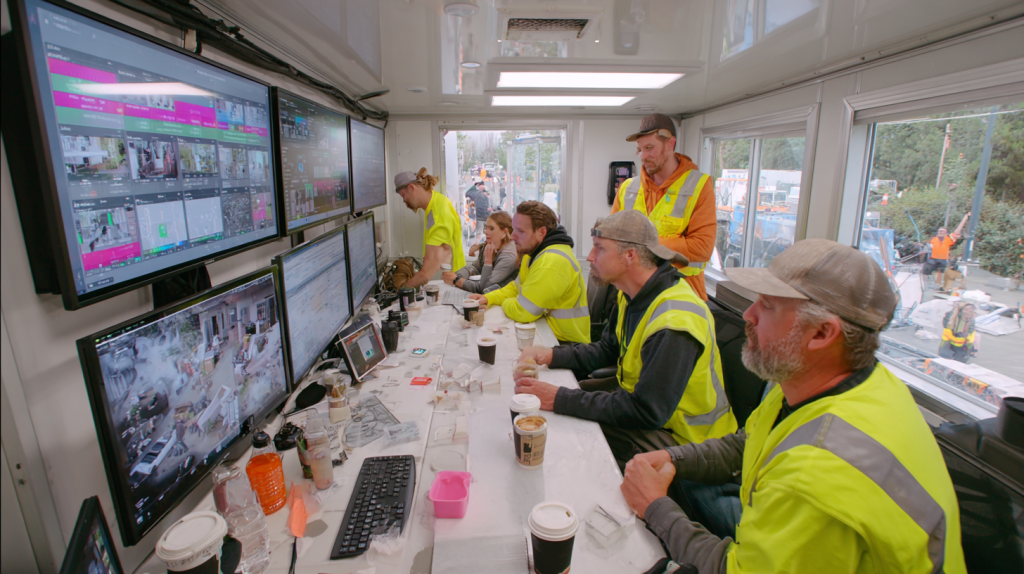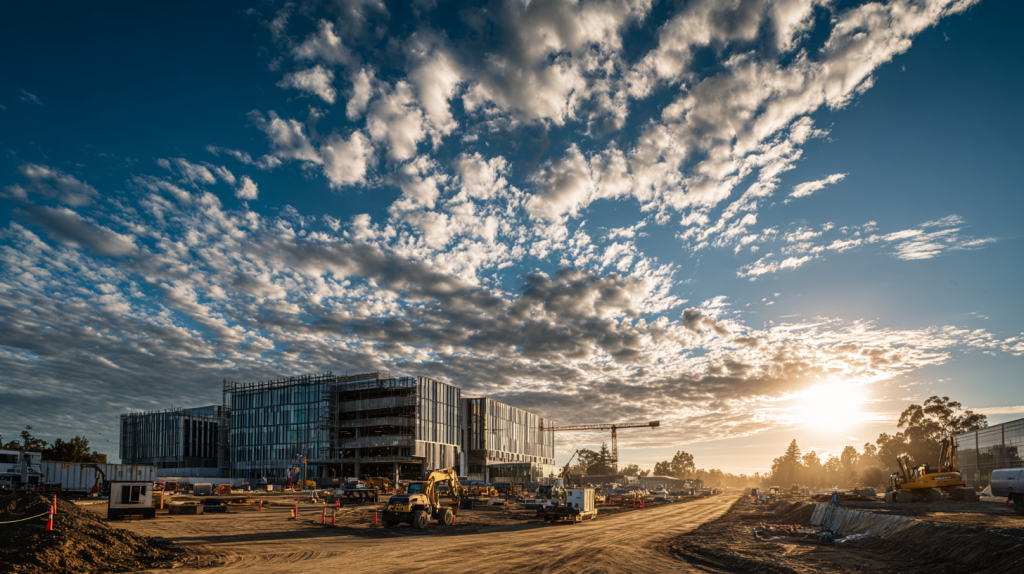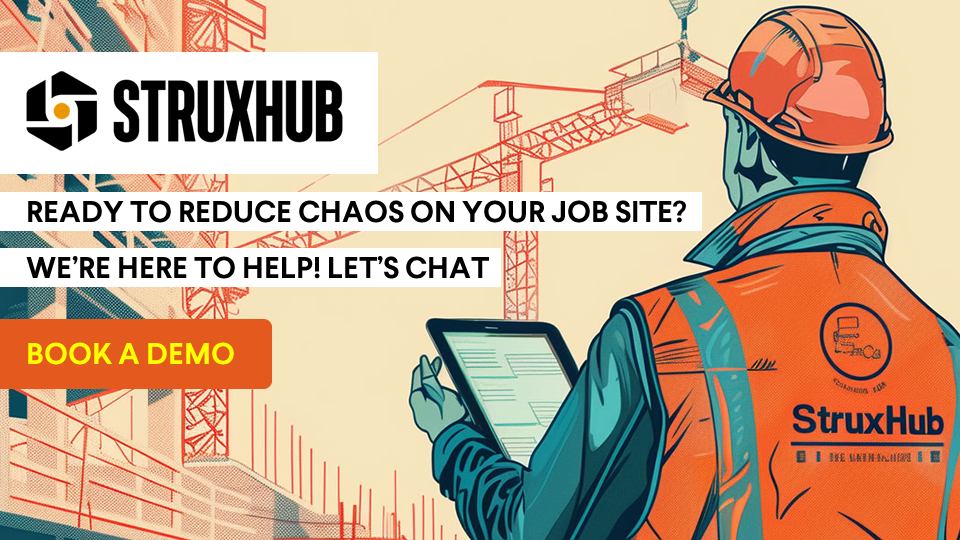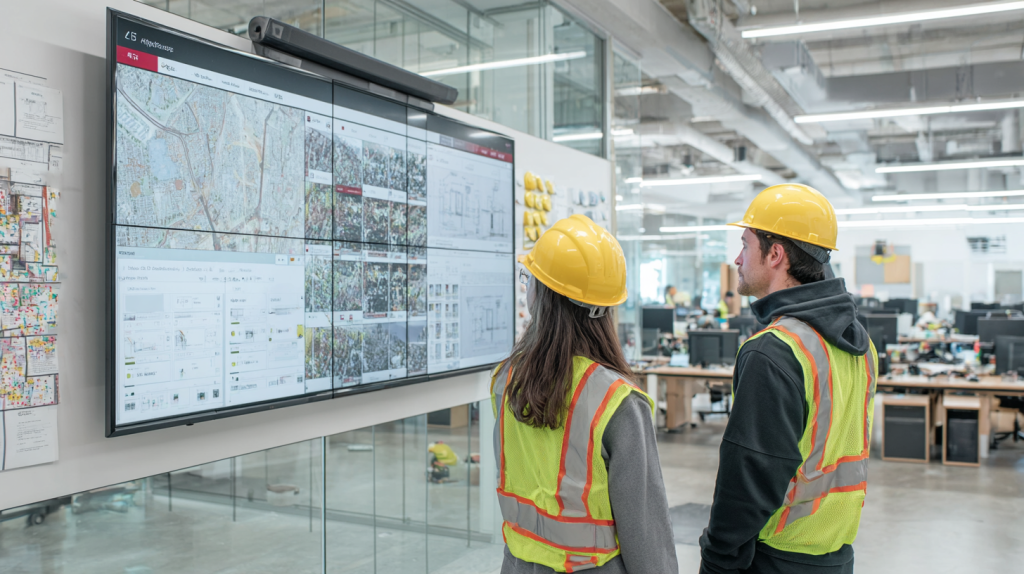Best Guide to Construction Logistics Plans (CLPs): What Owners Want to See Before Work Starts
Table of Contents:

Every major construction project begins long before the first excavator hits the ground. Owners, cities, and project stakeholders now expect a detailed Construction Logistics Plan (CLP) that proves the general contractor understands how to manage space, traffic, safety, and materials before mobilizing on site. A well-crafted CLP is not just paperwork—it’s a preview of project control, safety culture, and readiness.
For superintendents, project managers, and logistics coordinators, the CLP answers vital questions: How will deliveries be staged? Where will cranes swing? How will pedestrian and emergency routes remain open? With today’s emphasis on urban density and sustainability, owners want visibility into every step—how your team will minimize disruption, reduce idling emissions, and maintain compliance with city ordinances.
Modern CLPs rely heavily on GIS mapping, AI-assisted forecasting, and digital collaboration tools. When integrated with StruxHub’s scheduling, deliveries, and forms modules, your logistics plan transforms from a static PDF into a living, data-driven framework. It demonstrates control, builds owner trust, and shortens the review cycle.
As we explore how to build an owner-ready CLP, we’ll cover spatial planning, delivery management, risk mitigation, and digital reporting—all through workflows proven by StruxHub clients managing large commercial builds.

StruxHub
Experience the power of StruxHub today and witness firsthand how it can revolutionize your construction operations.
The Foundation of a Strong Construction Logistics Plan
A good CLP starts with clarity: what’s happening, where, when, and by whom. Owners evaluate how your plan protects the public, keeps trades productive, and maintains access for surrounding businesses or residents. A complete logistics plan defines gate locations, laydown zones, crane radii, vehicle routes, and pedestrian diversions—with visual overlays for each project phase.
Using GIS tools, you can layer traffic data, delivery windows, and environmental constraints. AI then helps forecast congestion risks by analyzing overlapping activities or time-window conflicts. These insights help you adjust early, before a single truck arrives.
Digital collaboration completes the loop. The CLP becomes part of a shared workflow—connected to the StruxHub Deliveries and Schedule modules—so every stakeholder sees real-time updates. When inspectors or owners request revisions, you can update live instead of redlining static documents.
How do project teams establish the foundation effectively?
- Define gate and route maps using GIS before mobilization.
- Integrate the map with live scheduling to show phasing and sequence.
- Assign update ownership so one person controls version integrity.
Why does this matter for general contractors and owners?
- It demonstrates foresight, improves permitting turnaround, and prevents costly mid-construction revisions.
What trends are shaping CLPs today?
- Real-time digital twins, predictive logistics, and sustainability metrics are becoming standard expectations.
Top Features
- GIS-based visual plan linked to schedule phases
- Integrated delivery and access routes
- Version control with live updates
Top Benefits
- Faster owner approval cycles
- Reduced traffic conflicts and city violations
- Better coordination among trades and vendors
Best Practices
- Align CLP creation with your 3-week look-ahead schedule
- Validate routes through on-site walkthroughs and drone data
- Maintain one master document—no parallel versions
FAQ
Q: Why do construction teams create a CLP?
A: To prove readiness, mitigate risk, and communicate logistics clearly to owners and city authorities.
Q: How does it improve coordination or ROI?
A: Clear logistics reduce rework, idle time, and delivery delays—directly improving profit margins.
Q: Is it scalable for large projects?
A: Yes, digital CLPs adapt easily across multiple phases or campuses.
Q: How does it enhance safety and compliance?
A: It documents protected walkways, access routes, and staging per code.
Q: Where can contractors learn more?
A: Visit StruxHub’s blog for logistics and scheduling best-practice articles.
A detailed, digital CLP is the first impression that convinces owners your team is ready to deliver with precision and control.
Related StruxHub articles
- Best Construction Scheduling Software for General Contractors and Superintendents
- Construction Data Analytics: The Power of Visualization and Automated Reporting
Internal links used: https://struxhub.com/products/deliveries/ • https://struxhub.com/products/schedule/ • https://struxhub.com/resources/blog/

Coordinating Deliveries, Routes, and Staging Before Groundbreaking
Before mobilization, owners expect proof that deliveries and equipment moves won’t disrupt surrounding streets or residents. This is where your CLP becomes operational rather than theoretical. It should include detailed gate plans, haul routes, delivery time windows, and staging diagrams that align with city noise, access, and environmental regulations.
Using StruxHub Deliveries, you can assign gate capacities, driver check-in protocols, and real-time updates directly within your plan. AI-assisted scheduling then analyzes traffic data and nearby projects to avoid overlapping deliveries that strain limited routes. This not only prevents gridlock but also improves relations with city agencies that monitor construction impact.
Your plan should visualize traffic flow by time of day and phase. For example, a morning pour might route concrete trucks differently from afternoon material drops. Each scenario should have mitigation measures—flaggers, escorts, signage, and detour routes—outlined clearly.
How are project managers adopting digital delivery coordination?
- They pre-approve routes in GIS, link them to deliveries, and distribute QR-coded gate instructions.
- They collect driver check-ins and exceptions using mobile forms for transparency.
What problems does this solve?
- Eliminates overlapping arrivals, unsafe maneuvers, and standby delays while ensuring public safety.
How does integration help?
- Gate IDs, permits, and time windows synchronize automatically with the project schedule.
Top Features
- Digital gate management and delivery scheduling
- AI congestion forecasts
- Mobile check-in and exception logging
Top Benefits
- Smoother material flow and fewer traffic incidents
- Lower standby charges and community complaints
- Faster city inspection approvals
Best Practices
- Set gate reservations at least 72 hours ahead
- Use driver QR codes for access validation
- Track and analyze repeat delivery delays for improvements
FAQ
Q: What problem does this solve on jobsites?
A: It ensures delivery efficiency while complying with traffic and safety rules.
Q: What results do teams see?
A: Predictable delivery windows and higher productivity with reduced downtime.
When deliveries and routes are planned digitally, logistics shift from reactive coordination to proactive control.
Related StruxHub articles
- Mastering Delivery Scheduling in Construction: Essential Techniques and Best Tools — Delivery Scheduling
- StruxHub Streamlines Construction Material Deliveries with Advanced Scheduling and Coordination Tools — Deliveries
Internal links used: https://struxhub.com/products/deliveries/ • https://struxhub.com/products/forms/

Communicating Safety, Compliance, and Sustainability Expectations
Owners increasingly judge contractors by their commitment to safety, compliance, and environmental stewardship. A strong CLP demonstrates how your team will manage site safety per OSHA and local standards, maintain noise and dust control, and ensure emergency access throughout construction.
Integrating StruxHub Forms lets superintendents digitize safety inspections, daily checklists, and incident logs directly within the logistics framework. AI can analyze recurring hazards or bottlenecks, prompting corrective actions before inspections identify them. For environmental reporting, digital forms capture fuel usage, waste metrics, and dust-control verification, all tied to your GIS map for location-specific tracking.
Sustainability is no longer optional. Cities and owners expect measurable outcomes—electric vehicle delivery options, reduced idling, recycling percentages, and community engagement efforts. Embedding these KPIs in your logistics plan communicates alignment with broader ESG goals.
How do GCs present safety and sustainability clearly?
- Include real-time dashboards for safety stats, waste tracking, and environmental compliance.
- Integrate digital inspections with automatic report submission to owners.
What challenges does this solve?
- Reduces paperwork, ensures audit readiness, and promotes transparency.
How does integration improve compliance?
- Field data instantly updates dashboards, so leadership can act before violations occur.
Top Features
- Digital safety and environmental reporting forms
- GIS-based location tracking for compliance metrics
- Real-time dashboards for inspections and audits
Top Benefits
- Faster reporting and reduced admin workload
- Stronger owner confidence during audits
- Proven ESG performance with measurable data
Best Practices
- Assign dedicated sustainability officers for data quality
- Schedule weekly safety audits with automated summaries
- Use mobile photos for visual proof of compliance actions
FAQ
Q: How do digital CLPs improve safety reporting?
A: They centralize data and eliminate paper gaps, giving owners confidence in your controls.
Q: Can sustainability metrics be integrated easily?
A: Yes—digital forms and dashboards track and visualize environmental performance.
Closing Sentence: A transparent safety and sustainability plan reassures owners that your logistics strategy protects people, community, and the environment.
Related StruxHub articles
- Best Guide to Construction Risk Management: How Top Contractors Control Jobsite Risk and Improve Field Accountability — Risk Management
- How AI Tools Are Automating Daily Construction Reports for Superintendents — AI Tools
Internal links used: https://struxhub.com/products/forms/ • https://struxhub.com/resources/blog/
Integrating Digital Systems and Communication Tools into the CLP
The best logistics plans aren’t static—they’re connected. When schedules, forms, and deliveries operate independently, information gaps multiply. But when all systems talk to one another, the CLP becomes a real-time operational dashboard. Integration with StruxHub’s scheduling, forms, and deliveries modules allows every change in the field to cascade through the entire project ecosystem automatically.
For instance, if a delivery delay occurs, the updated arrival time instantly reflects in the schedule. The superintendent’s team can reassign cranes or redirect crews before disruptions happen. Likewise, when a form submission flags a blocked access path, the system pushes a notification to logistics coordinators and project managers—creating a chain of accountability that doesn’t depend on phone calls or manual tracking.
This level of connectivity gives owners what they value most: predictability and transparency. A well-integrated plan shows how your team will track KPIs, update milestones, and manage communication loops efficiently. By documenting this digital workflow within your CLP, you demonstrate professionalism and readiness that goes beyond construction experience—it reflects digital maturity.
What systems make this effective?
- Scheduling, deliveries, and forms linked through one platform
- Cloud-based updates synced across mobile and desktop
- Role-based permissions ensuring data accuracy and security
How can integration improve execution?
- Automatic notifications keep teams aligned and prevent missed dependencies.
- Data visualizations in real-time dashboards give owners an instant performance snapshot.
What does a successful rollout look like?
- The CLP serves as both planning documentation and a live management system for day-to-day operations.
Top Features
- Unified scheduling and logistics synchronization
- Centralized document and approval workflow
- Automated updates and notifications
Top Benefits
- Fewer miscommunications between office and field
- Faster response time to issues or delivery changes
- Increased owner visibility and stakeholder trust
Best Practices
- Start integration during preconstruction to test workflows
- Define roles for updating and approving logistics changes
- Train all trade partners on digital tools before mobilization
FAQ
Q: What are common mistakes teams make during integration?
A: Launching tools without defining ownership or verifying data flows.
Q: How does StruxHub simplify communication?
A: It consolidates updates, tasks, and forms in one dashboard, ensuring no detail slips through the cracks.
A connected logistics plan powered by real-time communication gives owners confidence that your team can adapt quickly to any field change.
Related StruxHub articles
- AI Scheduling vs Real-Time Construction Software: What Works Best on the Jobsite? — Scheduling Tools
Internal links used: https://struxhub.com/products/home/ • https://struxhub.com/products/forms/ • https://struxhub.com/products/schedule/

Using Data, AI, and Predictive Analytics to Strengthen Owner Confidence
In 2025, data isn’t just a reporting tool—it’s a decision engine. Owners increasingly expect their general contractors to use analytics and AI to anticipate issues before they occur. Predictive modeling in your CLP demonstrates that your logistics plan can “see ahead,” identifying congestion, idle time, or resource bottlenecks weeks in advance.
AI-assisted scheduling within StruxHub can analyze patterns such as repetitive delivery delays, crane downtime, or recurring permit conflicts. These insights allow managers to adjust sequences, redistribute resources, or refine gate scheduling long before it affects productivity. Combined with field data collected through StruxHub Forms, you can create analytics dashboards that visualize metrics like on-time delivery rates, average offload durations, and compliance status in real time.
Owners appreciate when your plan includes measurable KPIs and continuous monitoring. Providing clear data paths—from plan to proof—converts subjective progress reports into verifiable performance. Whether through predictive dashboards or AI-driven scheduling alerts, the message to stakeholders is the same: you’re managing proactively, not reactively.
What new trends are influencing logistics data analysis?
- Predictive scheduling powered by AI and historical data
- Integration of drone or IoT sensor data for real-time verification
- KPI dashboards embedded in logistics documentation
How is AI reshaping CLP workflows?
- It automatically flags schedule conflicts, forecasts idle zones, and recommends optimal delivery windows.
What future innovations should contractors prepare for?
- Autonomous routing, voice-controlled reporting, and digital twins tied directly to city permitting databases.
Top Features
- Predictive analytics dashboard for logistics performance
- AI conflict detection for overlapping deliveries and crane operations
- Real-time reporting with owner access permissions
Top Benefits
- Data-backed decision-making and proactive risk control
- Higher owner confidence through transparent metrics
- Reduced downtime and increased scheduling accuracy
Best Practices
- Calibrate AI models using at least three months of field data
- Review dashboards weekly during progress meetings
- Align KPIs with owner contract requirements
FAQ
Q: How quickly can AI-driven insights show results?
A: Within the first few weeks as enough logistics and delivery data accumulates.
Q: Does AI replace superintendent judgment?
A: No—it strengthens it by surfacing patterns invisible in traditional reports.
Predictive analytics turn your logistics plan into a smart forecasting system that owners recognize as a true management advantage.
Related StruxHub articles
Internal links used: https://struxhub.com/products/schedule/ • https://struxhub.com/products/forms/
StruxHub
Discover how StruxHub can revolutionize your construction management. Contact us today!
Measuring Success and Continuous Improvement in Logistics Planning
The most successful CLPs don’t end when construction starts—they evolve throughout the project. Owners want to know your plan has built-in flexibility for monitoring, evaluation, and improvement. This ongoing refinement process not only boosts performance but also sets the stage for future project wins.
By using StruxHub Home and its connected dashboards, teams can track progress against baseline logistics KPIs such as delivery timeliness, staging efficiency, and safety compliance. As the project matures, this data becomes a feedback loop for optimizing future logistics plans and bids.
Continuous improvement starts with clear documentation. Every adjustment—whether a new gate assignment, route change, or shift in schedule—is logged automatically. Over time, these changes form a historical record that can be mined for insights or used to demonstrate compliance in post-project audits. With StruxHub’s unified data environment, lessons learned on one project seamlessly inform the next.
How can teams implement continuous improvement effectively?
- Conduct biweekly logistics reviews with all trade partners.
- Compare forecasted versus actual delivery and access metrics.
- Archive final data for use in future preconstruction planning.
What KPIs define success?
- Delivery on-time percentage, average wait time, compliance audit scores, and site congestion rates.
How does long-term adoption affect profitability?
- Data-driven planning reduces uncertainty, improves scheduling reliability, and strengthens owner satisfaction—leading to repeat business.
Top Features
- Multi-project logistics tracking and reporting
- Historical analytics library for benchmarking
- Real-time KPI dashboard with exportable data
Top Benefits
- Continuous performance improvement
- Stronger client relationships through transparency
- Lower operational risk and rework
Best Practices
- Embed logistics KPIs into weekly coordination agendas
- Review variance reports with trade partners for accountability
- Use insights to refine next project’s CLP proposal
FAQ
Q: How long before performance gains are noticeable?
A: Typically within 60–90 days of consistent data collection and review.
Q: What ensures long-term improvement?
A: Leadership commitment to analyzing results and acting on findings across every project cycle.
Treating logistics data as a long-term asset turns today’s coordination challenges into tomorrow’s competitive advantage.
Related StruxHub articles
- How General Contractors Use Real-Time Scheduling Software to Keep Projects Moving — Scheduling
- Best Guide to Construction Risk Management: How Top Contractors Control Jobsite Risk and Improve Field Accountability — Risk Management
- GIS for Construction: Top 6 Ways Superintendents and General Contractors Use GIS for Site Operation Planning and Scheduling Coordination— Command Centers
Internal links used: https://struxhub.com/products/home/ • https://struxhub.com/resources/blog/

How StruxHub Supports Contractors and Project Teams in Construction Logistics Planning
A great construction logistics plan doesn’t just look good on paper—it functions dynamically in the field. That’s where StruxHub comes in. The platform transforms traditional CLPs into living, connected systems that help general contractors, superintendents, and project managers stay in control from preconstruction through closeout.
With StruxHub Home, teams access every active project, milestone, and update in one organized dashboard. This visibility gives owners and executives a quick way to understand progress, logistics performance, and site readiness. When paired with StruxHub Schedule, project teams can align delivery sequencing, access routes, and phasing schedules without double data entry or offline files.
The StruxHub Deliveries module is the heartbeat of logistics management. It tracks every incoming truck, material shipment, and gate reservation—complete with time-window enforcement and digital gate check-ins. Delivery events automatically update across related modules, keeping schedules accurate and preventing costly standby fees.
Meanwhile, StruxHub Forms brings safety and compliance directly into the logistics workflow. Field crews use mobile devices to capture inspections, delivery confirmations, and permit validations that sync instantly with the office. For project owners, this integration means transparency—they can see evidence of coordination, compliance, and accountability in real time.
By combining scheduling, delivery tracking, forms, and dashboards into one ecosystem, StruxHub turns the Construction Logistics Plan into a dynamic, measurable strategy that owners can trust. It bridges preconstruction intent with field execution, ensuring that your logistics plan remains proactive, not reactive.
With StruxHub, project teams gain real-time visibility, clear communication, and the confidence to deliver every build on schedule.
Internal links used:
https://struxhub.com/products/home/
https://struxhub.com/products/deliveries/
https://struxhub.com/products/forms/
https://struxhub.com/products/schedule/
https://struxhub.com/resources/blog/




